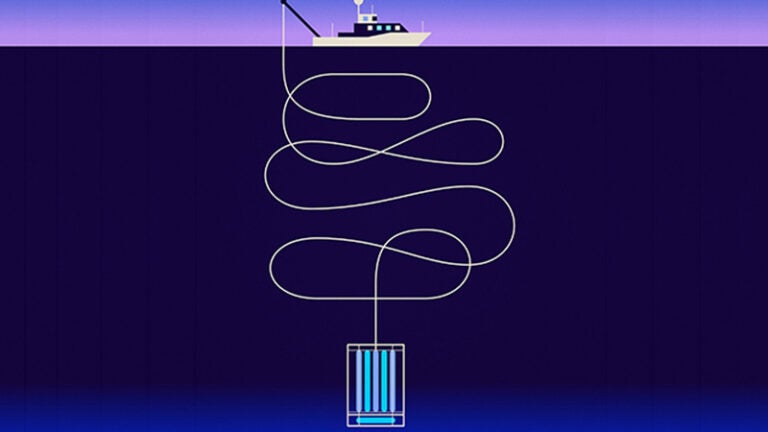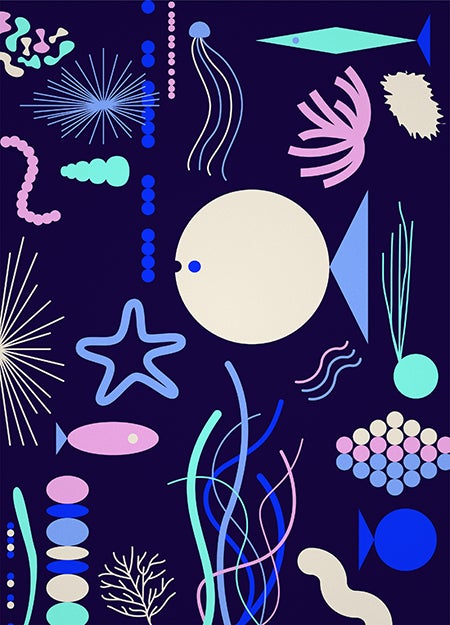
From Whence We Came
As animals began to leave Earth’s oceans about 400 million years ago to conquer dry land, they carried with them some of their ancestral homeland. Millions of generations of diverse lifeforms that followed, evolving across the eons, preserved that remnant of the seas as a vital part of their physiology. It was, quite literally, in their blood — the life-sustaining fluid mirrors the ocean’s composition in many ways.
When humans emerged onto the evolutionary scene, perhaps it was this vestige of life’s crucible coursing through their veins, combined with an overdeveloped sense of curiosity, that led them back to their familial home to explore, understand and, perchance, conquer once again the seas.
For some, their sense of purpose and adventure is fueled by their need to understand the complexities of the ocean, pulling from it answers that may help humans hold their place on the planet. That need also requires a love of — or at least a tolerance for — travel.
Journey to the sea
Douglas Capone’s interest in the ocean dates from his childhood. “I grew up in a coastal town in New Jersey,” he said, “and so all my young life, I was fishing and swimming and surfing.”
But his professional relationship with the sea would ripen when he ventured to college and graduate school. The son of first-generation immigrants who encouraged him to pursue medicine, he spent three years at Seton Hall as a pre-med student — until he realized the health profession was not for him and dropped out to hitchhike across the United States. He next traveled to Hawaii and surfed, then returned to the mainland and hitchhiked from California to Panama, where the money dried up.
“My parents helped me out and I came back home,” said Capone, who is now William and Julie Wrigley Chair in Environmental Studies and professor of biological sciences at USC Dornsife.
He worked for a year before finding his true direction, enrolling at the University of Miami, Coral Gables, to finish his bachelor’s degree in biology. While there, he gained his first experience performing research at sea, taking weekend oceanographic cruises off the Atlantic coast of South Florida with a graduate student mentor.
“He would drag me along to do all his routine analysis while he was out playing in the sea-grass beds,” Capone said. “I’d be doing Winkler titrations,” a method for measuring dissolved oxygen in water. But he loved the science. “It was fascinating.”
After completing his undergraduate studies, he enrolled as a graduate student at the University of Miami’s Rosenstiel School of Marine and Atmospheric Science. While there, he met Linda Duguay, who would become his life partner and spouse of nearly 40 years. (Duguay is associate professor (research) of biological sciences, director of the USC Sea Grant Program and director of research for the Wrigley Institute for Environmental Studies at USC Dornsife.)
Over the years, Capone has participated in numerous oceanographic research cruises, taking samples from points around the globe to study the biogeochemistry and ecology of microscopic algae called phytoplankton.

The “rainforests of the sea,” coral reef systems play home to diverse life forms of all shapes and sizes.
He has become a renowned expert on the role these organisms play in nitrogen fixation — the process of pulling nitrogen gas from the environment and converting it to a biologically useful form. Nitrogen is often the nutrient in lowest supply in many of the world’s ocean surface waters. His research has shown that nitrogen fixation may also affect how well some marine microbes are able to remove carbon dioxide, the most abundant greenhouse gas, from the atmosphere and produce oxygen in exchange.
“You know, 50 percent of the oxygen that’s in the atmosphere is coming from photosynthesis in the oceans,” Capone said. And since oxygen production and carbon dioxide fixation are “two sides of the same coin,” he notes, understanding how nitrogen fixation works — and how humans are affecting that process through pollution and other factors — could lead to answers about how to better reduce carbon dioxide in the atmosphere and thereby limit climate change.
All work and no play
Studies such as Capone’s require voyages to various regions in the open ocean and around coastal and reef systems to pull samples of water and sediments. Despite being referred to as “cruises,” these travels do not include time relaxing in deck chairs.
“I think it’s really amusing that we call them ‘research cruises’ because there’s definitely nothing cruise-like about them,” said Naomi Levine, Gabilan Assistant Professor of Biological Sciences and Earth Sciences at USC Dornsife.
As an undergraduate at Princeton University in New Jersey, Levine was a self-described “hard-rock geologist,” a term more literal than whimsical, as it refers to her studies in geological sciences. A course in the biogeochemistry of the oceans sparked her interest in marine geology, but it wasn’t until her doctoral work through Woods Hole Oceanographic Institute’s Joint Program in Oceanography with the Massachusetts Institute of Technology that she sailed on her first scientific cruises.
For about two years, she would fly to Bermuda, prepare her work and head out to sea for a week of sample collection, return to Bermuda to analyze samples, and fly back to Massachusetts for two weeks.
“So, it’d be two weeks in Bermuda, two weeks at home, two weeks in Bermuda, two weeks at home,” she recalled. “Everyone would say, ‘Wow, you have the most glamorous Ph.D., you’re going to Bermuda,’ but I didn’t actually have time to enjoy the island.”
Adding to the challenge of the grueling schedule, Levine is prone to seasickness.
“My first [cruise] was in February, and February in the Atlantic is not a particularly fun time. So, it was throw up in the sink, analyze samples, throw up in the sink, analyze samples,” she said, the memory drawing a fleeting look of discomfort to her expression.
Despite this, Levine loves going to sea. “There is something majestic about being out on the open water. The experience of being on research boats and experiencing the ocean up close is such a formative and crucial experience for an oceanographer,” she said.
Her graduate research centered on developing computational models of how the ocean changes over time and how microbes are affected by climate change, particularly with respect to the cycling of carbon throughout the environment. The work, ongoing in her USC Dornsife lab, earned her prestigious and highly competitive grant awards from the Simons Foundation and the Alfred P. Sloan Foundation.
As the work she and Capone are doing demonstrates, the biology of marine microbes and climate change are intertwined. Levine’s models could help researchers better understand how the two are interconnected, which may help scientists who are working to find solutions to the mounting problems stemming from climate change.
Raising reefs
Carly Kenkel’s research takes her to the sites of some of Earth’s most stunningly diverse and vibrant biological communities, coral reefs — where she is witness to tragedy. Few ecosystems show the disastrous results of global warming more clearly than these “rainforests of the sea,” as she calls them.
Kenkel, Gabilan Assistant Professor of Biological Sciences at USC Dornsife, first felt the call of the sea as an undergraduate at Southampton College in Long Island, New York City (later absorbed by the State University of New York at Stony Brook). She worked for a while at a marine mammal rescue facility but wanted something “more intellectually challenging.”
“There is something majestic about being out on the open water.”After interning in a few labs, she landed at Mote Marine Laboratory and Aquarium in Sarasota, Florida, where she made her first foray into the biology of corals, studying the ecology of microbes that live among them. But there was so much more.
“The analogy is that reefs are like the rainforests of the sea,” she said. “They’re the foundation of the biodiversity because you need that three dimensional structure to have habitat for all of the animals that live on the reef.”
She later enrolled in a Ph.D. program at The University of Texas at Austin and has since taken research cruises to reef systems such as Australia’s Great Barrier Reef, Micronesian atolls, systems off the Florida Keys and the Flower Garden Banks in the Gulf of Mexico.
Reef spawning counts among her favorite experiences. Like most immobile sea organisms, corals must release their reproductive cells, called gametes, into the water and hope they find counterparts from the same species.
“They have to synchronize their reproductive time, and it’s done according to lunar cycles and temperature,” she said. Some release their gametes in a trickle, others “like a nuclear explosion,” Kenkel said. “The entire colony just knows, and it’s just like a sneeze or something and they just all release. It’s stunning to see.”
But these marine gardens are experiencing a phenomenon known as “bleaching” caused by rising ocean temperatures driven by global warming. Bleaching turns the coral white and can lead to their complete die off, leaving behind dead white skeletons.
Kenkel and other scientists are fighting back, looking for ways to farm corals in controlled environments and transplant them into the wild. By studying coral genetics, their relationship with various microbes and other factors, Kenkel hopes to understand how some species handle changes in temperature better than others. The work will help these coral farmers raise and transplant specimens that survive and even thrive despite increasing environmental stresses.
Fount of life
Kenkel’s work, and that of Levine, Capone and other scientists studying the world’s oceans, may prove crucial to the persistence of life as we know it. Species such as corals and phytoplankton, and their interaction with the chemistry of the sea and atmosphere, lie at the foundation of Earth’s global ecosystem. They are the keystone to the future. As goes their health and that of the oceans — the ancestral home to all life on Earth — so goes the health of the entire planet.
Read more stories from USC Dornsife Magazine’s Spring-Summer 2018 issue >>